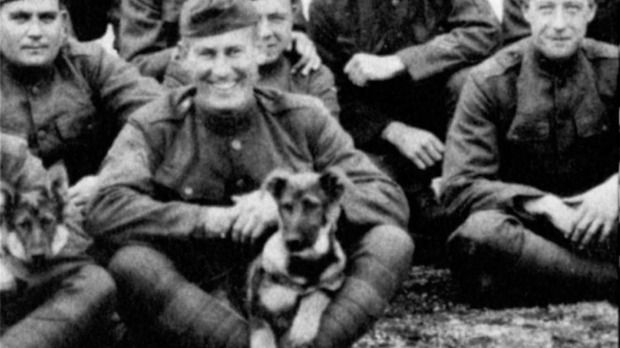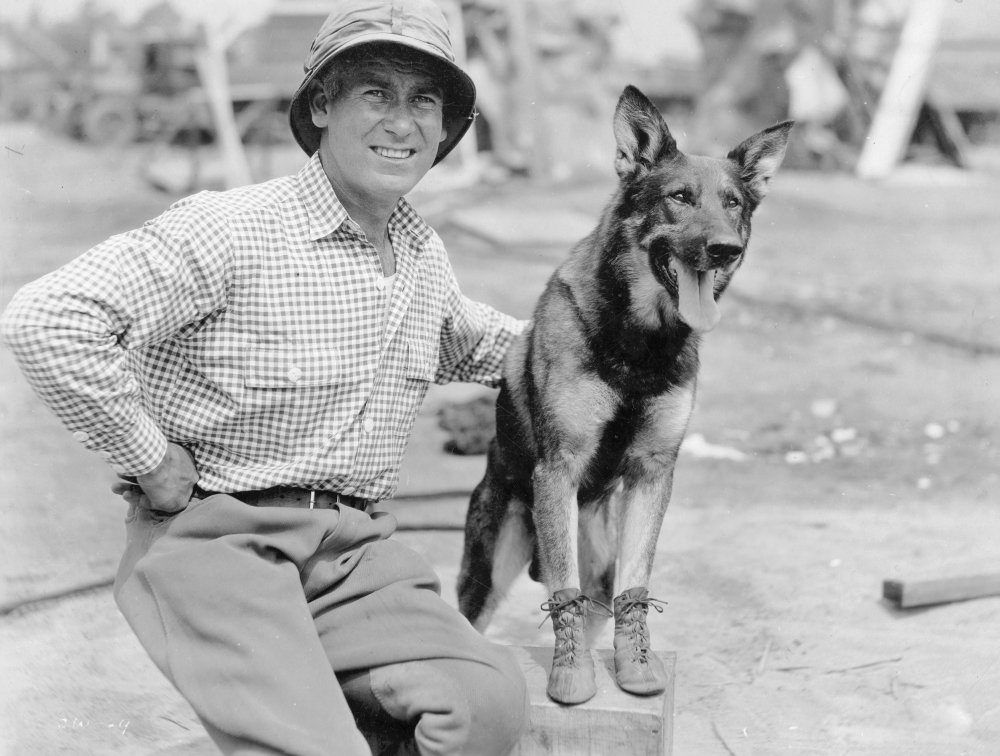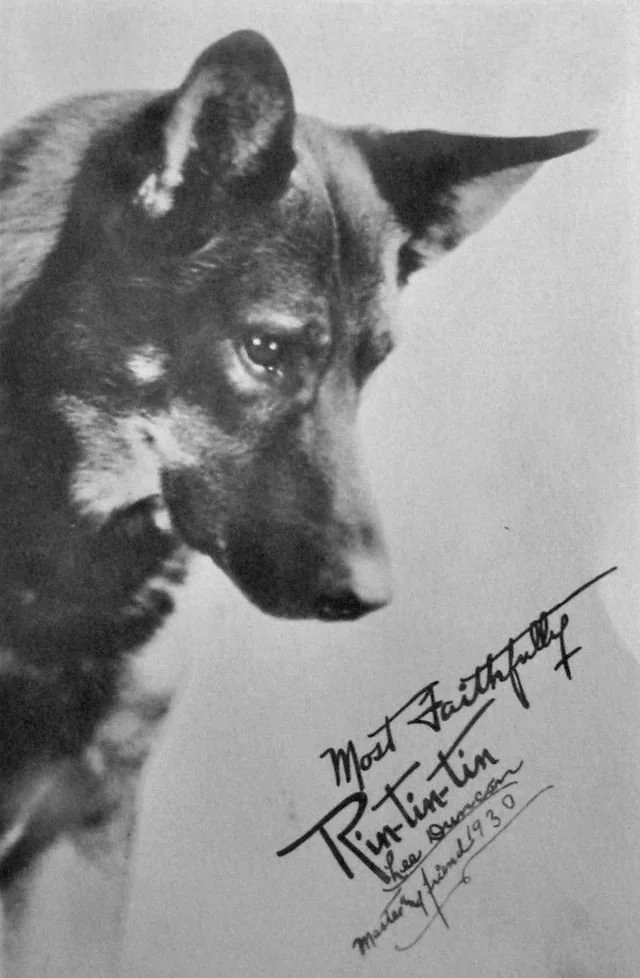When a dog becomes a cultural icon.
Rin Tin Tin is one of the most famous dogs in the history of cinema. Born in 1918, this German Shepherd captivated the world with his on-screen exploits, becoming an icon of the film industry during the silent film era and even beyond.
The Origins of Rin Tin Tin
Rin Tin Tin was born in the trenches of World War I, in a kennel in Flirey, Lorraine, then occupied by the German army. The region, heavily bombed by aviation and artillery, housed a severely damaged kennel used by the Imperial German Army for breeding German Shepherds. Corporal Lee Duncan found there an emaciated female and her five puppies, less than a week old, their eyes still closed. He rescued the mother and her pups, bringing them back to his unit. Once the puppies were weaned, Lee Duncan gave the mother to an officer and entrusted three puppies to other soldiers, keeping one male and one female. He considered these two puppies to be good luck charms. He named them Rin Tin Tin and Nanette, after good luck dolls named Rintintin and Nénette, often given by French children to American soldiers.

Rin Tin Tin and Corporal Lee Duncan. On the left, Nanette.
In July 1919, Lee Duncan discreetly brought the dogs aboard a ship returning him to the United States at the end of the war. Arriving in Long Island, New York, for administrative formalities, he entrusted his dogs to a breeder in Hempstead, Leo Wanner, who specialized in training police dogs. Nanette was diagnosed with pneumonia, and the breeder gave Lee Duncan another female German Shepherd. Lee Duncan left Hempstead by train for California with his dogs, but Nanette died during the trip. In tribute, he named his new puppy Nanette II, while continuing to call her Nanette. Rin Tin Tin and Nanette II produced at least 48 puppies. Lee Duncan kept two and sold or gave away the others.
 The Discovery of Talent
The Discovery of Talent
In 1922, Lee Duncan became one of the founding members of the Shepherd Dog Club of California in Los Angeles. At competitions, Rin Tin Tin demonstrated his incredible agility. He had learned to perform impressive jumps and was filmed by Charley Jones, an acquaintance of Lee Duncan who had just developed a camera capable of filming in slow motion. Seeing his dog on film, Lee Duncan became convinced that Rin Tin Tin could be the next canine star, much like Strongheart, a famous German Shepherd living in a stucco villa with his own street number in the Hollywood Hills, near his owners’ home.
The dog made his first appearance on a film set in a short film titled "The Man from Hell's River," replacing a wolf that was too shy. His talent for following instructions and his natural charisma left no one indifferent. In 1923, Warner Bros negotiated a deal with Rin Tin Tin and Lee Duncan for a five-year contract at $250 per week and 10% of the films’ net profits.
The Film Career
Rin Tin Tin became a true star with his first feature film, "Where the North Begins" (1923). The film was a phenomenal success and propelled Rin Tin Tin to stardom. Warner Bros received thousands of fan letters and replied with a signed photo and a message written by Lee Duncan: "Very faithfully, Rin Tin Tin." In total, he starred in 27 films, often playing the role of the loyal and courageous hero, saving his human masters in perilous situations. His most memorable films include "Clash of the Wolves" (1925) and "A Dog of the Regiment" (1927). Each of these films was a huge success, generating considerable profits for Warner to the point that it was said he had saved the studio from bankruptcy. Rin Tin Tin was highly sought after and signed several advertising contracts with dog food manufacturers. Rin Tin Tin’s success inspired many imitations by other studios seeking to capitalize on his popularity, notably Ace the Wonder Dog, also a German Shepherd. Around the world, Rin Tin Tin was extremely popular, as being a dog, he was understood by all audiences. At that time, silent films were easily adapted to various countries by simply changing the language of the intertitles.

The End of an Era
While Rin Tin Tin maintained his popularity in Hollywood, the arrival of talking films in 1927 profoundly affected his career. Warner Bros ended their collaboration with the dog and his master in December 1929, preferring to focus on promoting the stars of talking films, a field where Rin Tin Tin, a silent film star, obviously could not compete. Despite this, Lee Duncan continued to look for opportunities and partnered with independent producer Nat Levine, who gave Rin Tin Tin new roles in serials and films.
On August 10, 1932, Rin Tin Tin passed away at Lee Duncan’s home, located on Club View Drive in Los Angeles. Lee Duncan recalled this moment in his memoirs. He explained that he had heard Rin Tin Tin bark in an unusual way and went to see what was wrong. He found the dog lying on the ground, moments from death. The news of his death caused a strong nationwide reaction in the United States. Programs were interrupted by a news bulletin, and an hour-long tribute broadcast was aired the next day. Radio and print media praised his qualities and described the loss of Rin Tin Tin as a tragedy, an irreplaceable figure of American and international culture. Lee Duncan had his body repatriated to France, where he was buried in the Asnières cemetery, in the Hauts-de-Seine (92). He continued to promote the Rin Tin Tin bloodline, breeding and featuring other German Shepherds under that name in various media, including the famous 1950s television series.

The Legacy of Rin Tin Tin
Rin Tin Tin was not just a movie actor; he became a symbol of loyalty and bravery, profoundly influencing society’s perception of dogs. He was one of the first animals to receive a star on the Hollywood Walk of Fame. His popularity also helped promote German Shepherds as both companion and working dogs, despite a tarnished reputation during the war due to their association with Germany.
Rin Tin Tin’s influence never really faded. The 1950s TV series introduced Rin Tin Tin to a new generation, and even today, his name embodies courage and loyalty. Lee Duncan died on September 20, 1960, never having trademarked the name "Rin Tin Tin." The bloodline continued in Texas thanks to Jannettia Brodsgaard Propps, who had acquired several direct descendants of Rin Tin Tin, and then to her granddaughter Daphne Hereford after her death in 1988. In 2011, Daphne passed the lineage to her daughter, Dorothy Yanchak. The current Rin Tin Tin is the twelfth direct descendant of the silent film star and participates in events across the country to promote responsible pet adoption. Films, books, and even merchandise continue to celebrate this exceptional dog. Rin Tin Tin’s stories reinforced the idea that animals, just like humans, can be heroes.